Wall Bed Market Research, 2035
The global wall bed market size was valued at $3.5 billion in 2023, and is projected to reach $7 billion by 2035, growing at a CAGR of 6.2% from 2024 to 2035. A wall bed is a space-saving furniture solution designed to fold vertically against a wall or into a cabinet when not in use. This innovative design maximizes floor space in compact living environments, making it particularly popular in urban apartments, studio spaces, and multifunctional rooms. Wall beds are engineered with durable mechanisms that allow seamless folding and unfolding, often with added features such as hydraulic lifts or automated systems for convenience. Modern wall beds are not just functional but also aesthetically appealing, with customizable options that blend seamlessly with interior decor. It can be integrated with additional furniture elements such as shelves, desks, or sofas, creating versatile, dual-purpose spaces. The growing need for efficient use of space, driven by urbanization and shrinking living spaces, has fueled the wall bed market demand across residential and commercial markets.

Market Dynamics
Rapid urbanization has drastically reduced the size of living spaces, particularly in cities where land is scarce, and property prices are steep. As a result, individuals and families are increasingly opting for compact apartments or studio flats. This trend has driven the demand for innovative, space-saving furniture, with wall beds emerging as a popular solution. Wall beds, which fold into the wall when not in use, allow homeowners to optimize their limited space efficiently. These beds are particularly advantageous for homes that double as workspaces, as they can be folded away during the day to create more usable living or working areas. Additionally, the trend of minimalist living, where consumers prioritize functionality over excess, has further fueled the adoption of such versatile furniture. Governments in countries such as China and India, promoting affordable housing projects, have also indirectly boosted the wall bed market growth, as compact furniture such as wall beds perfectly complements smaller housing layouts. This convergence of urbanization, rising housing costs, and shifting lifestyle preferences is a significant driver for the market, encouraging manufacturers to develop products that meet the demand for space efficiency while maintaining aesthetic appeal.
The modern consumer is no longer satisfied with single-purpose furniture; instead, they seek products that can perform multiple functions and adapt to changing needs. Wall beds epitomize this trend, offering dual functionality as both a bed and a component of living room furniture when folded. This dual-use design has broad appeal in homes where every square foot counts, especially in urban settings. Technological advancements have further enhanced the versatility of wall beds, allowing them to be integrated with additional features such as desks, shelves, or even sofas. These features make wall beds highly suitable for households looking to maximize space without compromising on utility or aesthetics. Additionally, the demand for furniture that fits seamlessly into evolving lifestyles such as work-from-home arrangements has further elevated the market's prospects. Homeowners and renters alike value products that provide flexibility, enabling them to adapt their spaces to different needs throughout the day. This growing preference for multi-functional furniture has also encouraged manufacturers to invest in innovative designs and materials, ensuring that wall beds are durable, visually appealing, and easy to operate which is expected to create opportunities for manufacturers during the wall bed market forecast.
The global trend toward compact and modular housing solutions has significantly influenced the demand for wall beds. Compact homes are becoming more popular due to rising real estate costs and a growing preference for minimalist living, especially among young professionals and small families. These homes are designed to maximize functionality within limited spaces, and wall beds play a crucial role in achieving this. By folding into a wall or cabinet, these beds free up valuable floor space, allowing rooms to serve multiple purposes throughout the day. For instance, a bedroom with a wall bed can easily transform into a study or a living area. This functionality aligns perfectly with the needs of urban dwellers in regions such as Asia-Pacific and Europe, where small apartments are common. Additionally, governments in several countries are promoting affordable housing initiatives to address urbanization challenges, indirectly boosting the demand for space-saving furniture such as wall beds. The popularity of compact homes also extends to vacation properties, where owners seek versatile furniture to accommodate guests without overcrowding. Wall beds cater to this requirement, making them an integral part of the compact home ecosystem. With these factors driving their adoption, wall beds are positioned as a must-have solution for small-space living.
The introduction of smart technologies into wall beds offers immense growth potential for the market. Automated wall beds equipped with motorized mechanisms enable users to fold or unfold the bed effortlessly, making them particularly appealing to individuals with physical disabilities or the elderly. These advanced designs can include wireless control, remote operation, or mobile app connectivity, aligning well with the growing adoption of smart home technologies. Furthermore, smart wall beds can integrate additional functionalities such as programmable lighting, USB charging ports, and even temperature-controlled mattresses, enhancing the product's appeal among tech-savvy and luxury-oriented consumers. With home automation gaining traction globally, integrating wall beds with smart home ecosystems ensures seamless operation, such as automatically folding the bed when not in use. Manufacturers who innovate in this domain can tap into premium segments and differentiate their offerings, setting them apart in a competitive market. Besides residential applications, automated features make wall beds more practical for commercial uses in hotels, hostels, or healthcare facilities. As these technologies become more accessible and affordable, their adoption is expected to accelerate, making smart features a significant driver of growth in the wall bed industry.
Emerging markets in regions such as Asia-Pacific, Africa, and Latin America present untapped growth opportunities for wall bed manufacturers. Rapid urbanization, coupled with a growing middle class, has led to increased demand for affordable housing solutions. Compact apartments are becoming the norm in cities such as Mumbai, So Paulo, and Lagos, thereby driving the need for space-efficient furniture. Wall beds fit well into this scenario, as they allow homeowners to maximize space without compromising functionality. However, cost sensitivity in these regions necessitates the production of affordable models without sacrificing quality. Manufacturers can also localize production to reduce logistics costs and tailor products to regional preferences, such as specific bed sizes or materials. Strategic partnerships with local distributors and e-commerce platforms can further enhance market penetration in these regions.
Segmental Overview
The wall bed market is segmented into product type, operation, end user, distribution channel, and region. By bed type, the market is fragmented into single, double, and others. By operation, the market is fragmented into manual, automatic, and hybrid. By end user, the market is segmented into the residential and commercial. On the basis of distribution channel, it is divided into hypermarkets and supermarkets, specialty stores, online retail, and others. Region wise, the market is analyzed across North America, Europe, Asia-Pacific, and LAMEA. By region, it is analyzed across North America (the U.S., Canada, and Mexico), Europe (France, Germany, Italy, Spain, UK, Russia, and rest of Europe), Asia-Pacific (China, Japan, India, South Korea, Australia, and rest of Asia-Pacific), and LAMEA (Brazil, South Africa, Saudi Arabia, UAE, Argentina, and rest of LAMEA).
By Product Type
By product type, the single segment dominated the global wall bed market in 2023 and is anticipated to maintain its dominance during the forecast period. The single bed market is driven by the increase in trend of urbanization and the subsequent need for space-efficient living solutions. As metropolitan areas continue to expand, housing units are shrinking, necessitating furniture that maximizes utility in limited spaces. Single beds cater to this demand, especially in small apartments, dormitories, and shared living spaces. Affordability is another significant driver, as single beds are cost-effective and appeal to budget-conscious consumers, including students and young professionals.
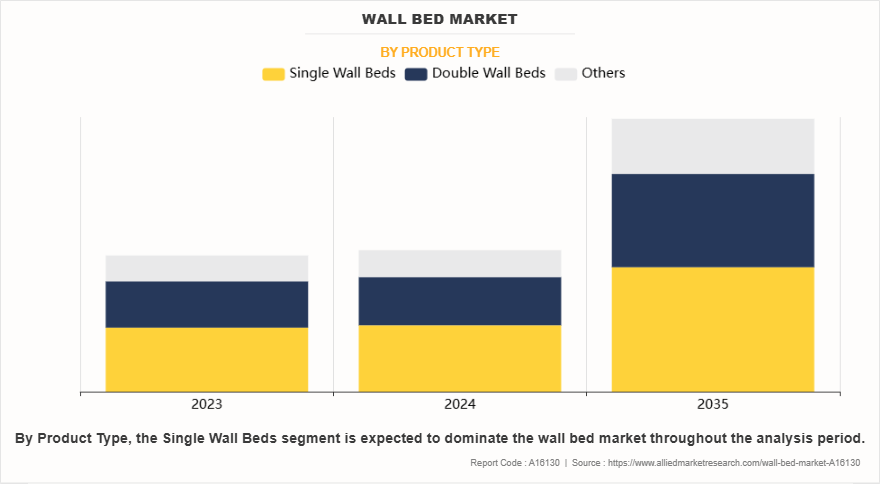
By Operation
By operation, the manual segment held the major wall bed market share in 2023 and is anticipated to maintain its dominance during the forecast period. These beds are especially prevalent in developing regions where cost-effective solutions are essential. Healthcare facilities often favor manual beds because they require no electricity, thus reducing operational costs and making them suitable for regions with unstable power supplies. Moreover, manual beds are robust and low maintenance compared to their automatic counterparts, appealing to users who prioritize durability over advanced features.
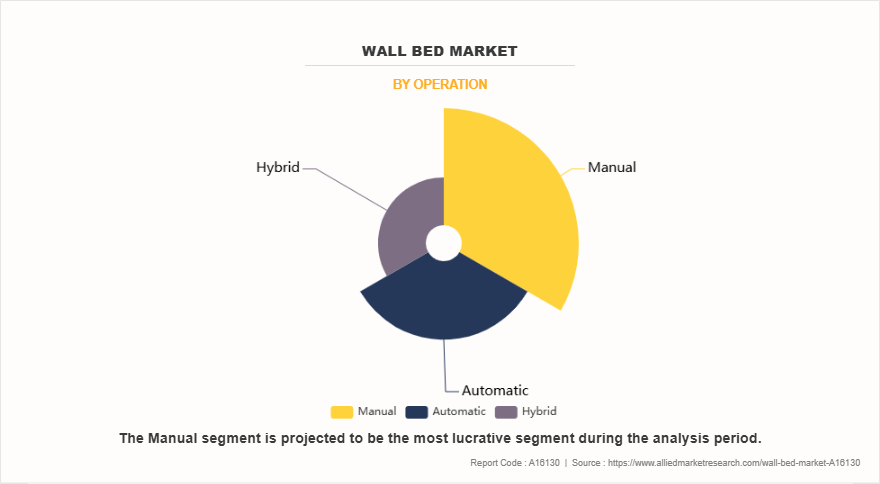
By End User
By end user, the residential segment dominated the global wall bed market in 2023 and is anticipated to maintain its dominance during the forecast period. The residential bed market is driven by the growing emphasis on home improvement and interior aesthetics, particularly as urbanization leads to more compact living spaces. With a rising global population and an increasing number of nuclear families, the demand for beds that maximize space while offering functionality has surged. For instance, space-saving solutions such as sofa beds, loft beds, and trundle beds are popular in urban areas where housing units are smaller.
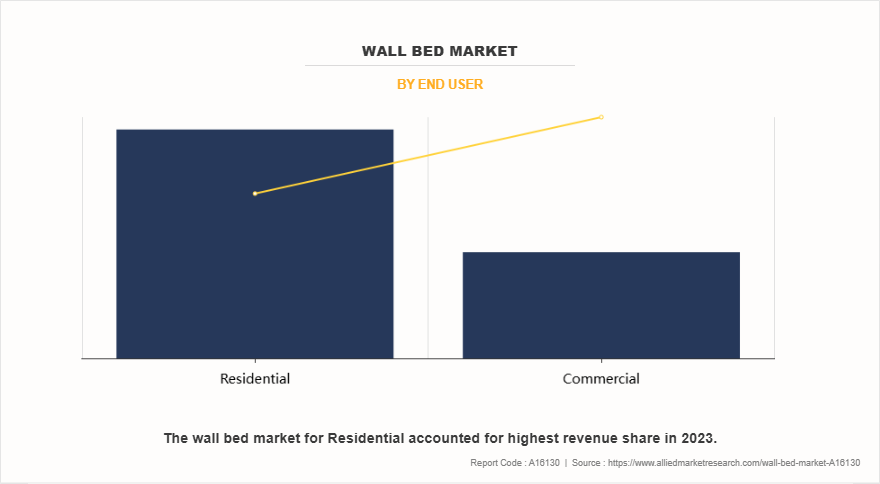
By Distribution Channel
By distribution channel, the hypermarkets and supermarkets segment dominated the global wall bed market in 2023 and is anticipated to maintain its dominance during the forecast period. The hypermarkets and supermarkets distribution channel thrives on convenience and affordability, thus attracting budget-conscious consumers seeking accessible solutions for their furnishing needs. These stores offer an all-in-one shopping experience, allowing customers to purchase beds alongside other home essentials. With their widespread presence in urban and suburban areas, hypermarkets and supermarkets reach a large customer base, especially in developing economies where organized retail is expanding rapidly.
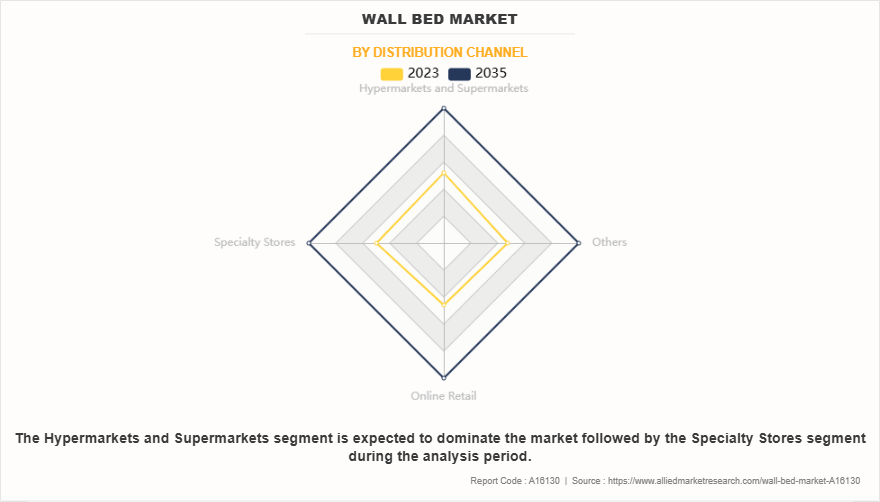
By Region
Region-wise, North America is anticipated to dominate the wall bed market with the largest share during the forecast period. Many cities across the U.S. and Canada are experiencing high population densities, which has created a demand for compact and versatile furniture solutions. Wall beds, also known as Murphy beds, allow residents to maximize their available space without compromising comfort or functionality. Another key factor is the growing trend of multi-functional furniture in North America, which aligns with modern minimalist lifestyles. Consumers are increasingly drawn to furniture pieces that provide dual purposes, such as a bed that can be transformed into a desk or a sofa.
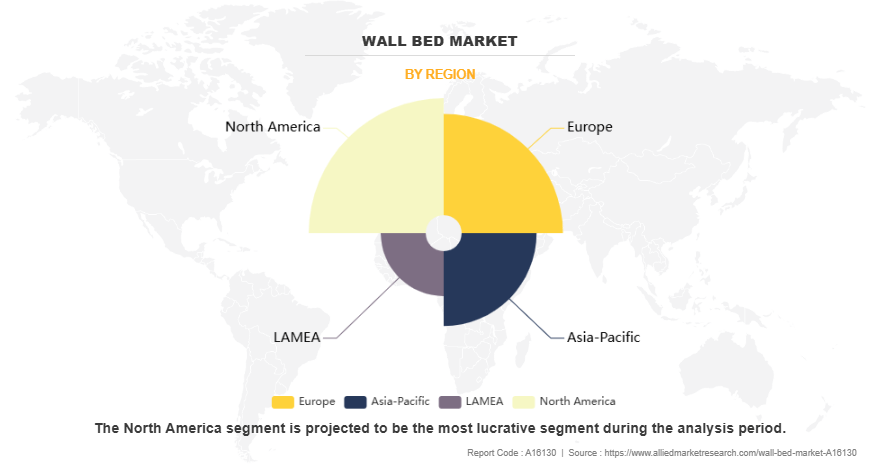
Competition Analysis
The key players profiled in the global wall bed market report include Twin Cities Closet Company, Inc., Murphy Wall Beds Hardware Inc., Wilding Wallbeds, Inc., FlyingBeds International, Inc., Bestar Inc, B.O.F.F. Wall Beds, LLC., SICO Inc., Wall Beds Manufacturing Ltd., The London Wallbed Company, Co., and The Bedder Way Co. Several well-known and upcoming brands are vying for market dominance in the expanding wall bed industry. Smaller, niche firms are more well-known for catering to consumer demands and preferences. Large conglomerates, however, control most of the market and often buy innovative start-ups to broaden their product lines.
Key Benefits For Stakeholders
- This report provides a quantitative analysis of the market segments, current trends, estimations, and dynamics of the wall bed market analysis from 2023 to 2035 to identify the prevailing wall bed market opportunities.
- The market research is offered along with information related to key drivers, restraints, and opportunities.
- Porter's five forces analysis highlights the potency of buyers and suppliers to enable stakeholders make profit-oriented business decisions and strengthen their supplier-buyer network.
- In-depth analysis of the wall bed market segmentation assists to determine the prevailing market opportunities.
- Major countries in each region are mapped according to their revenue contribution to the global market.
- Market player positioning facilitates benchmarking and provides a clear understanding of the present position of the market players.
- The report includes the analysis of the regional as well as global wall bed market trends, key players, market segments, application areas, and market growth strategies.
Wall Bed Market Report Highlights
| Aspects | Details |
| Market Size By 2035 | USD 7 billion |
| Growth Rate | CAGR of 6.2% |
| Forecast period | 2023 - 2035 |
| Report Pages | 320 |
| By End User |
|
| By Distribution Channel |
|
| By Product Type |
|
| By Operation |
|
| By Region |
|
| Key Market Players | Bestar Inc., The Bedder Way Co., B.O.F.F. Wall Beds, LLC., The London Wallbed Company, Co., Wilding Wallbeds, Inc., Inovabed, Murphy Wall Beds Hardware Inc., SICO Inc, Wall Beds Manufacturing Ltd., Wallbeds “n” More |
Analyst Review
The demand for space-saving furniture solutions, such as wall beds, is rising globally due to increasing urbanization and shrinking living spaces. Key market players are adopting strategies such as innovative product launches to fuel the growth of the wall bed market. By introducing advanced, aesthetic, and compact designs, manufacturers aim to cater to both residential and commercial consumers. The growing popularity of foldable and multifunctional furniture is a critical driver in the adoption of wall beds.
Urbanization, particularly in metropolitan areas, has led to smaller apartments and compact housing units, driving the demand for wall beds that optimize space without compromising functionality or style. Additionally, the rise in single-person and dual-income households supports the trend of furniture that combines sophistication with space efficiency. Wall beds are increasingly viewed as a stylish and practical solution to enhance household aesthetics.
The global wall bed market was valued at $3,472.2 million in 2023 and is projected to reach $6,960.3 million by 2035, registering a CAGR of 6.2% from 2024 to 2035.
The wall bed market is segmented into product type, operation, end user, distribution channel, and region. By bed type, the market is fragmented into single, double, and others. Based on operation, the market is fragmented into manual, automatic, and hybrid. By End User, the market is segmented into the residential and commercial. On the basis of distribution channel, it is divided into hypermarkets and supermarkets, specialty stores, online retail, and others. Region wise, the market is analyzed across North America, Europe, Asia-Pacific, and LAMEA. By region, it is analyzed across North America (the U.S., Canada, and Mexico), Europe (France, Germany, Italy, Spain, UK, Russia, and rest of Europe), Asia-Pacific (China, Japan, India, South Korea, Australia, and rest of Asia-Pacific), and LAMEA (Brazil, South Africa, Saudi Arabia, UAE, Argentina, and rest of LAMEA).
North America is the largest regional market for wall bed
The key players profiled in the wall bed market report include Twin Cities Closet Company, Inc., Murphy Wall Beds Hardware Inc., Wilding Wallbeds, Inc., FlyingBeds International, Inc., Bestar Inc, B.O.F.F. Wall Beds, LLC., SICO Inc., Wall Beds Manufacturing Ltd., The London Wallbed Company, Co., and The Bedder Way Co.
The global wall bed market report is available on request on the website of Allied Market Research.
Loading Table Of Content...
Loading Research Methodology...


